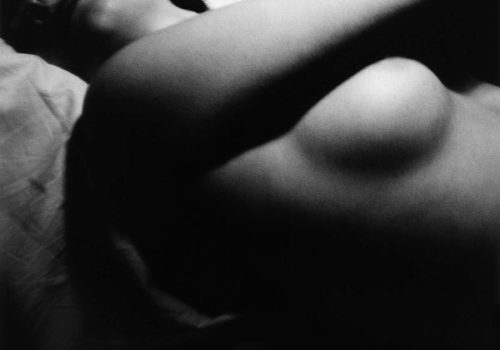The body as landscape, object, sculpture, and form, as costume, architecture, or anything else you could imagine it to become in all of its glory. It is both positive and negative, being and nothingness. It is present and absent, past and future, paradoxes intertwined and connected as one. In a state of simultaneity that is impossible to recognize fully but at the same time it is the thing in which we are forever traveling, consciously and unconsciously.
The body is both object and symbol of the object itself, and the female form most of all assumes the passive role of being that which we act upon, as we exalt its beingness into an abstract meditation on life itself. It is a thing of beauty to behold and perhaps no one does it quite like Bill Brandt whose female nudes have been collected in two volumes twice in his lifetime. The first in Perspective of Nudes (1961) and again in Bill Brandt: Nudes 1945–1980. Now, the oeuvre is brought together in a single volume, Brandt Nudes (Thames & Hudson), which includes a preface by Lawrence Durrell and commentaries by Mark Haworth-Booth. It is here, in Brandt Nudes, that we can consider Brandt’s relationship to the female form throughout the course of his esteemed career.
As Brandt recalls in quoted text from a piece first published in 1933, “It was after the war, when I was busy photographing London celebrities for English and American magazines, that I began to feel irritated by the limitations imposed by such jobs. I was taking portraits of politicians, artists writers, actors, in their own surrounding, but there was never enough time for me to do what I wanted. My sitters were always in a hurry. Their rooms were rarely inspiring backgrounds, and I felt the need for exciting backgrounds to make pictures of the portraits. I wanted more say in the pictures; I wanted rooms of my own choice. And so I came to the nudes. Nudes, at that time, were photographed in studios. I thought of photographing them in real rooms…”
And so it began. Brandt took the nude out of the artist’s studio and set her free in the world. His photographs from this period have a tension inherent to this, a surreal feeling of being in a place they do not quite belong but making the most of it. Brandt’s women are never come hither so much as they are lost in their own worlds, even when they look at the camera they are no more aware of their nudity than they are of the curtains open in the window behind the bed. There is a mannered naturalism that is pervasive in these images, a sense of the female embodying her femininity without using it in a vulgarly eroticized manner.
AS Brandt continued working, his nudes began to take shape, not as women themselves but as larger more luxurious landscapes. They slowly become a form unto themselves, sculptural masses of bone, muscle, and flesh, or personalities somewhere inside, sometimes alluringly coming to the surface in frozen glimpses of a fiery soul. But for the better part Brandt’s nudes are forever in a state of monumental repose. They are languid fields of flesh, sometimes nothing more than a part that takes on a stately shape unto itself. Consider the feet crossed, seen only from the sole, slowly becoming a kind of creature that is both foreign and familiar. The nudes transition into graphic expressions of positive and negative space, and offers a peaceful mediation between the organic form of the body and the constructed form of the human landscape of the interior room and its insistent regularities that make it comfortable and confining at the same time.
It is Brandt’s nude that reminds us of a life spirit that pervades the body itself, that makes it more than just a mass of flesh but the vehicle for a spirit that is luminous on the page, a play of light and shadow, motion and stasis. As Brandt continues his explorations, his images become more intense in the contrasts between black and white on the page itself. The body is cropped into sharp angles and soft folds, curves and forms that echo each other as you move about the woman herself.
As John Szarkowski noted of Brandt’s word in 1970: “These pictures—at first viewing, strange and contorted—reveal themselves as supremely posed and untroubled works. It has been said that these pictures concern the world of pure form and space, but surely they also concern the bodies of women… not abstract but depersonalized, their content is I think after all a transcendent eroticism—a suspended, euphoric celebration of the flesh. In photograph only Edward Weston has made nudes of equal power.”
Miss Rosen
















